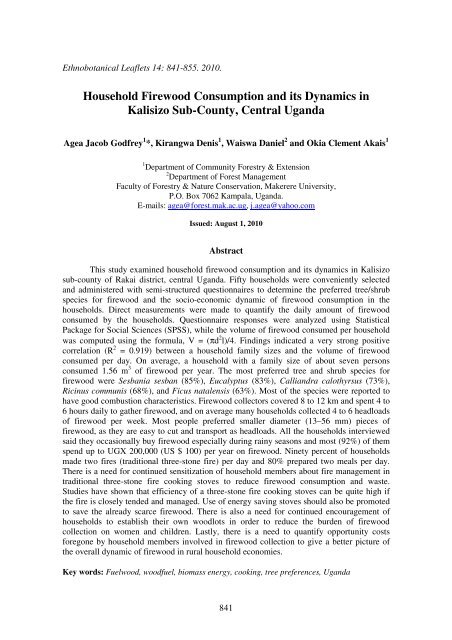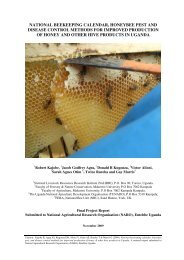Household Firewood Consumption and its Dynamics in Kalisizo Sub ...
Household Firewood Consumption and its Dynamics in Kalisizo Sub ...
Household Firewood Consumption and its Dynamics in Kalisizo Sub ...
Create successful ePaper yourself
Turn your PDF publications into a flip-book with our unique Google optimized e-Paper software.
IntroductionThe ma<strong>in</strong> use of the world’s wood is not as build<strong>in</strong>g materials or paper, but asfuel. It is a pattern both ancient <strong>and</strong> modern, <strong>and</strong> one that is not likely to change <strong>in</strong> thenext several decades (Matthews, 2000). Today, hundreds of millions of people rema<strong>in</strong>completely reliant upon wood for energy <strong>and</strong> cannot anticipate any rapid transition toother energy sources. In fact, woodfuels are the world’s most important form of nonfossilenergy burn<strong>in</strong>g (FAO 1999). It occupies enviable place for provid<strong>in</strong>g many people,especially the poor <strong>and</strong> rural households, with a primary source of energy (Leach <strong>and</strong>Mearns 1988; Eberhard 1990; Hall 1994; Delali et al. 2004). Of the 4.4 billion cubicmeters (m³) of wood harvested <strong>in</strong> 1996, close to half (1.9 billion m³) are burned forcook<strong>in</strong>g or to provide heat, or are used to make charcoal for later burn<strong>in</strong>g (FAO 1999).Leach <strong>and</strong> Mearns (1988) estimated that 79% of the total traditional energy consumed <strong>in</strong>develop<strong>in</strong>g countries is fuelwood <strong>and</strong> between 60% <strong>and</strong> 69% of this is <strong>in</strong> sub-SaharanAfrica. Wood consumed annually for fuel energy <strong>in</strong> sub-Saharan Africa <strong>in</strong>creased from1,500 million m 3 to 3,500 million m 3 between 1950 <strong>and</strong> 1990 (Durn<strong>in</strong>g 1991).In India for <strong>in</strong>stance, an estimated 70% of the energy requirement is met byfuelwood collected from forests <strong>and</strong> marg<strong>in</strong>al l<strong>and</strong>s (MEF 1996). In parts of theHimalaya per capita annual fuelwood consumption ranged between 500 <strong>and</strong> 1200 kg(Metz 1990). The natural forests of Siloti <strong>and</strong> Chanoti <strong>in</strong> the Himalayas supports 70%<strong>and</strong> 80% of the two villages respectively, for their fuelwood needs (Tewari et al. 2003).In Africa, highly efficient energy resources like kerosene or liquid gas are rare <strong>and</strong>expensive. Therefore, firewood <strong>and</strong> charcoal will most likely be major energy resources<strong>in</strong> the com<strong>in</strong>g decades (Pak 2005). Charcoal has lower transport costs per unit energy <strong>and</strong>higher energy content per tonne but it is produced <strong>in</strong>efficiently, so that the scarcity ofenergy resources is even <strong>in</strong>creased if it is switched from fuelwood to charcoal. The socialaspects of the household also <strong>in</strong>fluence the efficiency of use of firewood <strong>and</strong> charcoal.The fireplace is an important location <strong>in</strong> the social life. In regions where plenty offuelwood is available, people like to keep the fire a bit longer than is needed only forcook<strong>in</strong>g (Pak 2005). To sit around the fire is as common <strong>in</strong> Africa as <strong>in</strong> many othercultures.In Ug<strong>and</strong>a, firewood is the most significant source of energy, <strong>and</strong> the majority ofthe people employ it for domestic use <strong>and</strong> small-scale <strong>in</strong>dustries, e.g. brick <strong>and</strong> tilemak<strong>in</strong>g, agro process<strong>in</strong>g <strong>and</strong> fish process<strong>in</strong>g (Forestry Department 1992; NEMA 1998,Tabuti et al. 2003). In urban areas people use charcoal more than firewood. At presentbecause of national energy crisis, dem<strong>and</strong>/consumption for firewood <strong>in</strong> Ug<strong>and</strong>a isestimated to be grow<strong>in</strong>g at a rate of 3% per annum (MEMD 2007). From the historicaltrend of fuelwood use, it is apparent that there are multifaceted dimensions to utilizationrather than from economic perspectives only. The dimensions <strong>in</strong>clude livelihood options<strong>and</strong> strategies. Any disruption <strong>in</strong> availability <strong>and</strong> use of wood for fuel energy couldrender marg<strong>in</strong>alized households vulnerable to livelihood <strong>in</strong>security (Tabuti et al. 2003).This is likely to impact on other activities of the household (e.g., division of labour,842
Arnold, J.E.M., Köhl<strong>in</strong>, G. <strong>and</strong> Persson, R. 2006. Woodfuels, livelihoods, <strong>and</strong> policy<strong>in</strong>terventions: Chang<strong>in</strong>g Perspectives. World Devel., 34 (3): 596–611.Bembridge, T.J. <strong>and</strong> Tarlton, J.E. 1990. Woodfuel <strong>in</strong> Ciskei: a headload study. SouthAfrican Forest Journal, 154: 88–93.Bukh, J. 1979. Village women <strong>in</strong> Ghana. Centre for Development Research,Sc<strong>and</strong><strong>in</strong>avian Inst. African Studies, Uppsala.Delali, B.K.D., Witkowski1, E.T.F. <strong>and</strong> Shackleton, M.C. 2004. The fuelwood crisis <strong>in</strong>southern Africa – relat<strong>in</strong>g fuelwood use to livelihoods <strong>in</strong> a rural village.GeoJournal, 60: 123–133.Dewees, P.A. 1989. The woodfuel crisis reconsidered: observations on the dynamics ofabundance <strong>and</strong> scarcity. World Devel., 17 (8): 1173–1202.DFID. 2002. Energy for the poor: Underp<strong>in</strong>n<strong>in</strong>g the millennium development goals.Department forInternational Development, London.http://www.dfid.gov.uk/Documents/publications/energyforthepoor.pdf Accessed 15 May 2009.Durn<strong>in</strong>g, A. 1991. Sav<strong>in</strong>g the forests: what will it take? Worldwatch Paper 117.Worldwatch Institute, Wash<strong>in</strong>gton DC.Eberhard, A.A. 1990. Energy consumption patterns <strong>and</strong> supply problems <strong>in</strong>underdeveloped areas of South Africa. Devel. Southern Africa 7: 335–346.FAO. 1984. Underst<strong>and</strong><strong>in</strong>g tree uses <strong>in</strong> farm<strong>in</strong>g system. Workshop on plann<strong>in</strong>g fuelwoodprojects with participation of the rural people. Lilongwe, Malawi.FAO. 1999. The State of the World’s Forests, Food <strong>and</strong> Agriculture Organization, Rome,Italy.Fisher, M. 2004. <strong>Household</strong> welfare <strong>and</strong> forest dependence <strong>in</strong> Southern Malawi. EnvironDev Econ, 9: 135–154.Forestry Department 1992. The national biomass study, Phase I. Technical report. ForestDepartment, Nakawa, Ug<strong>and</strong>a: 229pp.G<strong>and</strong>ar, M.V. 1983. Wood Requirements of Rural People <strong>and</strong> an Approach to WoodlotDevelopment. Institute of Natural Resources, Natal University, Pietermaritzburg.Hall, D.O. 1994. Introduction, summary <strong>and</strong> conclusions. In Hall DO <strong>and</strong> Mao YS (Eds),Biomass energy <strong>and</strong> coal <strong>in</strong> Africa, pp. 1–16. Zed Books <strong>and</strong> AFREPEN.Hultsch, D.F., MacDonald, S.W., Hunter, M.A., Maitl<strong>and</strong>, S.B. <strong>and</strong> Dixon, R.A. 2002.Sampl<strong>in</strong>g <strong>and</strong> generalizability <strong>in</strong> developmental research: comparison of r<strong>and</strong>om<strong>and</strong> convenience samples of older adults. Int. J. Behav. Dev 26:345-359.Kohl<strong>in</strong>, G. <strong>and</strong> Amacher, G. 2006. Welfare implications of community forest plantations<strong>in</strong> develop<strong>in</strong>g countries: The Orissa Social Forestry Project. Am J Agric Econ,87(4): 855-869.Leach, G. <strong>and</strong> Mearns, R. 1988. Beyond the Woodfuel Crisis: People L<strong>and</strong> <strong>and</strong> Trees <strong>in</strong>Africa. Earthscan Publications Ltd., London.Madubansi, M. <strong>and</strong> Shackleton, C.M. 2007. Changes <strong>in</strong> fuelwood use <strong>and</strong> selectionfollow<strong>in</strong>g electrification <strong>in</strong> the Bushbuckridge lowveld, South Africa. J. Environ.Manag., 83 (4): 416-426.848
Matthews, E. 2000. Undy<strong>in</strong>g flame: the cont<strong>in</strong>u<strong>in</strong>g dem<strong>and</strong> for wood as fuel. Extractfrom Pilot Analysis of Global Ecosystems: Forest Ecosystems. EarthTrends 2001World Resources Institute.MEF. 1996. Annual report. M<strong>in</strong>istry of Environment <strong>and</strong> Forests, Government of India,New Delhi.MEMD. 2007. Renewable energy sources <strong>in</strong> Ug<strong>and</strong>a. M<strong>in</strong>istry of Energy <strong>and</strong> M<strong>in</strong>eralDevelopment, Kampala Ug<strong>and</strong>a.Metz, J.J. 1990. Conservation practices at upper elevation village of west Nepal. MRD,10(4): 7–15.MWLE. 2001. Forestry Sector Review. M<strong>in</strong>istry of Water, L<strong>and</strong>s <strong>and</strong> Environment,Kampala, Ug<strong>and</strong>a.NEMA. 1998. State of the environmental report for Ug<strong>and</strong>a. National EnvironmentalManagement Authority. Kampala, Ug<strong>and</strong>a.Pak, S.L. 2005. Climate change <strong>and</strong> Africa. Cambridge University Press, ISBN-13: 978-0521836340, pp412.REBR. 2000. Rakai East Basel<strong>in</strong>e Report. Rakai district, Ug<strong>and</strong>a.Tabuti, J.R.S., Dhilliona, S.S. <strong>and</strong> Lye, K.A. 2003. <strong>Firewood</strong> use <strong>in</strong> Bulamogi County,Ug<strong>and</strong>a: species selection, harvest<strong>in</strong>g <strong>and</strong> consumption patterns. Biomass &Bioenergy 25: 581–596.Tewari, J.C., Tripathi, D., Pratap, N. <strong>and</strong> S<strong>in</strong>gh, S.P. 2003. A study of the structure,energy fluxes <strong>and</strong> emerg<strong>in</strong>g trends <strong>in</strong> traditional Central Himalayan agroforestrysystems. Forests, Trees & Livelihoods 13(10): 17–38.UDIH. 2005. Ug<strong>and</strong>a Districts Information H<strong>and</strong>book. Founta<strong>in</strong> Publishers. Kampala,Ug<strong>and</strong>aWood, G.B. <strong>and</strong> Wiant, H.V Jr (Eds.). 1993. Modern Methods of Estimat<strong>in</strong>g Tree <strong>and</strong>Log Volume, Proc. IUFRO Conference, Morgantown, West Virg<strong>in</strong>ia, June 14-16,1993. West Virg<strong>in</strong>ia University Publication Services. 168 pp.World Bank. 2002. Report of the AFTEG/AFTRS jo<strong>in</strong>t sem<strong>in</strong>ar on household energy <strong>and</strong>woodl<strong>and</strong> management. Wash<strong>in</strong>gton, DC: World Bank.Yikii, F., Agea, J.G. <strong>and</strong> Kaboggoza, J.R.S. 2006. Eucalyptus versus <strong>in</strong>digenous trees:what do tobacco farmers prefer <strong>in</strong> Northwestern Ug<strong>and</strong>a. MURJ., 1(2): 171-177.849
Table 1. Socio-demographic characteristics of the respondents <strong>in</strong> <strong>Kalisizo</strong> subcounty,Rakai district, Ug<strong>and</strong>a.Variable % response (N = 50)SexFemale 93Male 07Age (years)< 20 1320-40 20> 40 67Marital statusMarried 57Widow/widower 28Divorced 15Education levelNo formal education 08Primary 70Secondary 22OccupationPeasantry farm<strong>in</strong>g 93Others (teach<strong>in</strong>g, causal labour<strong>in</strong>g) 07Family size*1 – 4 305 – 8 52> 8 18*Average household family size = 7 persons.850
Table 2. Tree species preferred for firewood <strong>in</strong> <strong>Kalisizo</strong> sub-county, Rakai district,Ug<strong>and</strong>a.Tree/shrub species Local name %responseOrig<strong>in</strong>DesirableattributesreportedDescriptive remarksSesbania sesban (L.)Merr.Muzimb<strong>and</strong>eya 85 Indigenous A, B, C Shrubby multi-branchedtree that grows about 5 to8 m tall.Eucalyptus spp. Kalitunsi 83 Introduced/naturalisedD, E, I, J Species grow to variablesheight (10-60 m). Highlycoppic<strong>in</strong>g when cut.Dra<strong>in</strong>s water from thesoil.Calli<strong>and</strong>racalothyrsus Meissn.Calli<strong>and</strong>ra 73 Introduced/naturalisedA, C, D,E,Small <strong>and</strong> thornlesslegum<strong>in</strong>ous tree grow<strong>in</strong>gup to about 12 m high.Ric<strong>in</strong>us communis L. Nsogasoga 68 Indigenous A, F Shrub-like multi-branchedherb grow<strong>in</strong>g to about 5metres high. Seeds verypoisonous.Ficus natalensisHochst.Mutuba 63 Indigenous C, G, D,H, I, JShrubby tree/stranglergrow<strong>in</strong>g up to about 20 mhigh or more. Bark usedfor mak<strong>in</strong>g bark cloth.Mangifera <strong>in</strong>dica. Muyembe 58 Introduced/naturalisedC, G, D,H, I, JFruit tree that grow toabout 35-40 m tall, withoften a wide crowndiameter of about of 20m.Leucaenaleucocephala (Lam.)De Wit.Leucaena 55 Introduced A, C, D, E Shrub/tree grow<strong>in</strong>g up toabout 15-18 m tall, forkedwhen shrubby <strong>and</strong>branch<strong>in</strong>g strongly aftercoppic<strong>in</strong>g.Markhamia lutea(Benth.) K.Schum.Combretum spp.Nsambya,lusambyaMukoola,Ndagi50 Indigenous G, H Upright evergreen treegrow<strong>in</strong>g 10-15 m high,with a narrow, irregularcrown.48 Indigenous D, G, H, J Shrub/small to mediumsize trees grow<strong>in</strong>g tovariables heights (3-20 mhigh).Bridelia micrantha(Hochst.) Baill.Katazamiti 40 Indigenous C, G, H, I Tree grow<strong>in</strong>g up to about20 m tall with a denserounded crown.851
Grevillea robusta A.Cunn. ex R. Br.Polyscias fulva(Hiern) Harms.Acacia hockii DeWild.Acacia mellifera(Vahl) Benth.Grevillea 35 Introduced C, G Medium-sized to largetree grow<strong>in</strong>g to about 12-25 m high with denseconical crown.Setala 23 Indigenous C, D, G Tree grow<strong>in</strong>g up to 25-30m high, with a regularbranch<strong>in</strong>g pattern <strong>and</strong> aclear, straight bole withbranches develop<strong>in</strong>g highup.Kasana 15 Indigenous D, I Small to medium-sizedtree, grow<strong>in</strong>g to about 15-17 m tall.Matovu 13 Indigenous D, I Low branched tree/shrubwith a more or lessspherical crown grow<strong>in</strong>goften as a dense thicket of2-5 m high.Senna spectabilis(DC.) H. S. Irw<strong>in</strong><strong>and</strong> R. C. Barneby.Cassia 10 Introduced/naturalisedD, I Small rounded treegrow<strong>in</strong>g 7-15 m tall witha spread<strong>in</strong>g crown.Sapium ellipticum(Hochst.) Pax.Musasa 08 Indigenous D, G, I Medium-sized tree up to12-15 m <strong>in</strong> height,occasionally reach<strong>in</strong>g 25m.Desirable attributes of firewood tree species reported by respondents: A=easy to ignite, B=easy to gather/harvest, C=multipurpose, D=quality fire, E=coppices quickly, F=easy to f<strong>in</strong>d, G= Burns for a long time, H=produces strongembers, I= has a hot flame, J=produces less smoke.852
4Volume of firewood used/year (cubic meters)3.532.521.510.50y = 0.2872x - 0.3801R 2 = 0.9191 3 5 7 9 11 13 15<strong>Household</strong> sizeFigure 1. Volume of firewood used per year by the household <strong>in</strong> <strong>Kalisizo</strong> subcounty,Rakai district (Averaged volume/year = 1.56 m 3 , averaged household size = 7 persons).853
100908070Meals per dayFires per day% response6050403020100Once a day Twice a day Thrice a dayNumber of meals <strong>and</strong> fires perdayFigure 2. Number of fires made <strong>and</strong> meals prepared per day by the households <strong>in</strong><strong>Kalisizo</strong> sub-county, Rakai district.854
Table 3. Socio-economic dynamic of firewood consumption <strong>in</strong> <strong>Kalisizo</strong> sub-county,Rakai district, Ug<strong>and</strong>a.Variable% responseTime (hours) spent on collect<strong>in</strong>g firewood for two-way trip1–3 224–6 667–9 12Distance (Km) covered for two-way trip3–7 188–12 72> 12 10Frequency of firewood collection (number of headloads per week)1–3 204–6 647–10 16Amount of money (Ug<strong>and</strong>a shill<strong>in</strong>gs) spent per year on firewood*100,000–200,000 92201,000–300,000 6>300,000 2*1 Ug<strong>and</strong>a shill<strong>in</strong>gs (UGX) = US $ 0. 0005855









